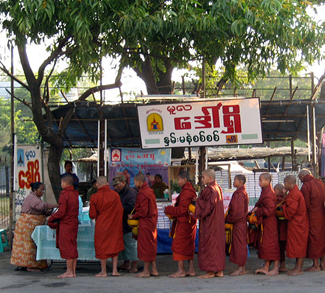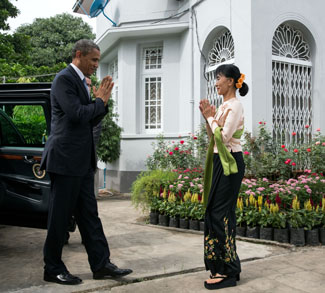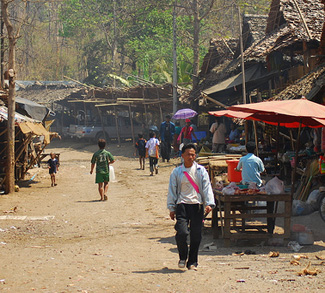Though tension and mistrust have long existed amidst the myriad of ethnic and religious groups that comprise Myanmar’s society, they erupted with uncommon severity during the violence of last year. In May 2012, following allegations that a Muslim had raped and murdered a Buddhist woman, a series of protracted riots rocked the western state of Rakhine, home to a large community of Muslim Rohingyas. The riots, which persisted through the summer of 2012 and reignited once more in October, killed hundreds, displaced thousands, and even prompted an intervention by Myanmar’s military.
The Rohingyas were easy targets for the Buddhist majority to rally against. Far from central Myanmar and ethnically distinct, many people in Myanmar consider them to be outsiders, occupying Myanmar’s territory without a legitimate claim to do so. They have been discriminated and legislated against, and are officially considered to be non-citizens under law.
However, the violent outburst of this past March hints at a more widespread hatred within the country. The violence occurred in Meiktila, a city in central Myanmar, against non-Rohingya Muslims, whose citizenship status cannot be questioned.
It began with an argument in a Muslim-owned shop in Meiktila, which escalated into a fight, and later saw a group of Muslim boys forcibly dragged into the street and brutally murdered by a cheering mob. After that, anti-Muslim violence spread outward, leaving a wake of ransacked homes and burnt mosques in several outlying towns, including Oh The Kone, a mere 50km from Rangoon, Myanmar’s former capital and largest city.
The aftermath of these attacks was bleak: rows of houses set to the torch, and thousands of Muslims displaced, being forced to live in guarded camps as refugees in their own country.
The government response has been somewhat inadequate, continuing what appears to be a growing pattern. Throughout the rioting in 2012, responses from Myanmar’s leaders either lacked sincerity, or were misguided, serving only to fan the flames and drive violence.
In keeping with this trend, government reactions to the killings and displacements of the past few months have been rather mild. Some reports have claimed that police stood by while violent crimes were committed, lacking either in motivation, direction, or wherewithal enough to stop them. President Thein Sein and the widely-beloved Aung San Suu Kyi issued a joint statement urging a respect for law and order, but aside from lip service to tolerance and peaceful coexistence, they have not outlined a plan to protect the rights of religious minorities, nor have they fully acknowledged how deep the animosity runs.
For Thein Sein and his military-aligned government, antagonizing Muslims is a political boon. Either by refusing to crackdown on these outbursts, or by periodically pledging actions as extreme as deporting all Rohingyas from Myanmar, he gains traction with the Buddhist majority. If allowed to compete openly and fairly, Suu Kyi’s National League for Democracy will almost definitely defeat Thein Sein. He is therefore seeking a wedge issue to even the playing field.
It is therefore in his political interest to court, or at the very least avoid alienating, the powerful Buddhist monks who form the heart of anti-Muslim sentiment. Though they may have a reputation for being passive and detached, the Buddhist religious leaders in Myanmar are far from cloistered. They form an important part of domestic civil society, and are deeply engaged in politics and the political climate. Many of the most outspoken and respected Buddhist leaders are wary of Islamic culture. They fear what they perceive to be the spreading of Muslim values and norms which contradict their own, and which they believe might lead to changes in society, such as the role and treatment of Buddhist women.
Capitalizing on these fears may be the best hope Thein Sein has in delaying the NLD’s rise to power. Suu Kyi has built her philosophy and her party on defending minorities and human rights in Myanmar, so eventually, she must choose between pandering to intolerance, thereby turning her back on what she stands for, or speaking out passionately against hate and discrimination, jeopardizing her long and arduous efforts to penetrate military governance. Thein Sein is no doubt hoping that Suu Kyi comes out firmly in favour of the Muslim minorities, thereby alienating a great many core Buddhist supporters, and driving them into his camp.
So far, however, Suu Kyi seems not to have made a decision. Certainly she has called for a restoration of order and a respect for one’s fellow citizens, but not with the fervour and passion she was able to muster when she was a political prisoner. Muslims, and especially the Rohingya, are so unpopular with such a large segment of Buddhists that she is forced to walk on eggshells.
It seems, then, that no one in the political leadership is willing to campaign against the growing intolerance and communal animosity that is spreading throughout Myanmar. It doesn’t take a crystal ball to know what happens next.




